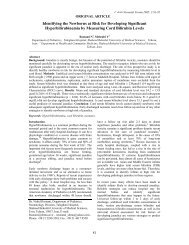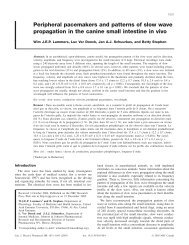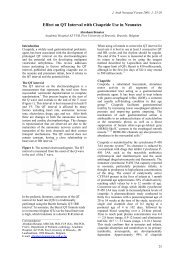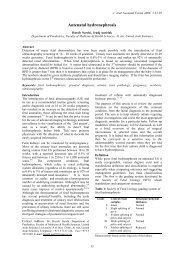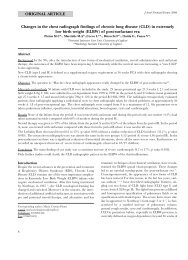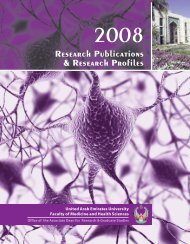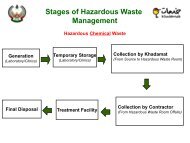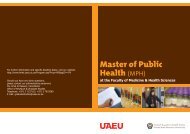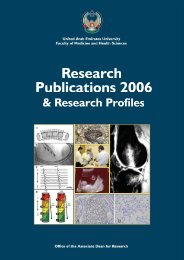Research Publications - College of Medicine and Health Science
Research Publications - College of Medicine and Health Science
Research Publications - College of Medicine and Health Science
Create successful ePaper yourself
Turn your PDF publications into a flip-book with our unique Google optimized e-Paper software.
Neurodegenerative Diseases<br />
Novel Selective Lig<strong>and</strong>s for Muscarinic Acetylcholine<br />
Receptors<br />
Five muscarinic acetylcholine receptor subtypes<br />
(M 1 - M 5 ) have been cloned <strong>and</strong> are found in the<br />
brain. However, the pharmacological identification<br />
<strong>of</strong> the subtypes responsible for the various<br />
central effects <strong>of</strong> the muscarinic drugs is difficult<br />
due to the lack <strong>of</strong> highly selective muscarinic<br />
agonists <strong>and</strong> antagonists. We have isolated<br />
muscarinic M 1 <strong>and</strong> M 4 receptor subtype selective<br />
toxins from mamba snake (Dendroaspis)<br />
venoms. At present the status <strong>of</strong> M 1 <strong>and</strong> M 4 receptors<br />
in health <strong>and</strong> disease states in humans<br />
are being investigated. Our results show significant<br />
decrease <strong>of</strong> M 4 , but not <strong>of</strong> M 1 receptors in<br />
the hippocampus <strong>of</strong> Alzheimer’s patients compared<br />
to controls. Moreover, changes in these<br />
receptors in adrenalectomized animal models<br />
which have been shown to have a selective loss<br />
<strong>of</strong> hippocampal neurons. Attempts to isolate<br />
<strong>and</strong> characterize M 2 , M 3 , <strong>and</strong> M 5 selective toxins<br />
is also in progress. Behavioral, biochemical <strong>and</strong><br />
electrophysiological techniques are also used in<br />
underst<strong>and</strong>ing the role <strong>of</strong> other neurotransmitters<br />
in diabetes, epilepsy, aggressive behavior,<br />
aging, <strong>and</strong> degenerative diseases.<br />
Pr<strong>of</strong>. MY Hasan<br />
Neuroscience<br />
The main line <strong>of</strong> research has been focusing<br />
on neurotransmission. We have been applying<br />
behavioral, biochemical <strong>and</strong> electrophysiological<br />
<strong>and</strong> morphological techniques<br />
in underst<strong>and</strong>ing the role <strong>of</strong> neurotransmitters<br />
in various disorders (diabetes, epilepsy, aging,<br />
neurodegenerative diseases). Findings indicated<br />
significant modification <strong>of</strong> specific neurotransmitters<br />
in many <strong>of</strong> the disorders. It appears that<br />
alteration in calcium mobilization <strong>and</strong> free radical<br />
system may be a common factor accounting<br />
for some <strong>of</strong> the changes observed in aging,<br />
diabetes <strong>and</strong> Parkinson’s disease. Another line<br />
<strong>of</strong> research has been toxicological studies <strong>and</strong><br />
impact <strong>of</strong> toxins on muscle the nervous system.<br />
We have investigated the effects <strong>of</strong> heavy<br />
metal Intoxication in relation to degenerative<br />
diseases. We studied impact <strong>of</strong> heavy metal<br />
toxicity on nervous system <strong>and</strong> muscle <strong>and</strong><br />
observed that free radicals may be involved in<br />
metal toxicity <strong>and</strong> antioxidants like ascorbic<br />
acid & alpha-tocopherol may have a protective<br />
role against metals effects Also we have been<br />
looking <strong>and</strong> neurotoxicity <strong>and</strong> general toxicity<br />
from organophosphates <strong>and</strong> nerve gases. We<br />
have been screening antidotes for organophosphate<br />
poisoning <strong>and</strong> implication for treating<br />
exposure to nerve gas agents. Furthermore<br />
my interest covered broad areas in medical<br />
education <strong>and</strong> community health. Some <strong>of</strong> the<br />
projects performed included; drug utilization<br />
<strong>and</strong> rational use <strong>of</strong> antibiotics <strong>and</strong> analgesics in<br />
health care centers <strong>and</strong> community, developing<br />
Sickness Impact Pr<strong>of</strong>ile for studying quality<br />
<strong>of</strong> life in infertile patients, studying views <strong>of</strong><br />
medical students <strong>and</strong> physicians <strong>of</strong> clinical skills<br />
teaching at the medical colleges <strong>and</strong> surveying<br />
patient’s attitudes towards students involvement<br />
in medical practice.<br />
�������������������<br />
Gastroenterology: Gastrointestinal diseases<br />
have increased in recent years. Work stress,<br />
alcohol, non-steroidal anti-inflammatory drugs<br />
(NSAIDS) strong tea or c<strong>of</strong>fees have contributed<br />
to the pathology. Our research is based on<br />
gastrointestinal secretion <strong>and</strong> the mechanism<br />
<strong>of</strong> action <strong>of</strong> PPIs <strong>and</strong> other acid inhibitors on<br />
acid secretion. In the early years, Histamine H2receptor<br />
antagonist, Sucralfate <strong>and</strong> Muscarinic<br />
receptor antagonists were used more <strong>of</strong>ten.<br />
But with the introduction <strong>of</strong> the proton pump<br />
inhibitors (PPIs) their use has declined owing to<br />
the potent anti-secretory <strong>and</strong> anti-ulcer activity<br />
<strong>of</strong> the PPIs. Recently we published the work<br />
on new proton pump inhibitor, esomeprazole,<br />
Astra-Zeneca (accepted for publication (2008)).<br />
At present we are studying the interactions <strong>of</strong><br />
Aspirin in combination with ibupr<strong>of</strong>en on Gastric<br />
acid <strong>and</strong> Ulcer formation in the rat in vivo<br />
<strong>and</strong> in vitro (manuscript in preparation). In the<br />
near future we are planning to study the effect<br />
<strong>of</strong> stress on the mucosa <strong>of</strong> FSL <strong>and</strong> FRL rats <strong>and</strong><br />
the healing rate <strong>of</strong> alcohol-<strong>and</strong> indomethacininduced<br />
ulcers in the same rats.<br />
Teratology: Epilepsy affects approximately 1% <strong>of</strong><br />
the world’s population <strong>and</strong> it is the second most<br />
common neurologic disorder after stroke. It is a<br />
heterogeneous symptom complex—a chronic<br />
disorder characterized by chronic seizures. Approximately<br />
0.5% <strong>of</strong> all pregnancies occur in<br />
women with epilepsy. It is known that epileptic<br />
women demonstrate a higher liability to obstetric<br />
complication than non-epileptic females <strong>and</strong><br />
congenital malformations are more common in<br />
their <strong>of</strong>fsprings than those <strong>of</strong> normal or rats.<br />
Department <strong>of</strong> Pharmacology<br />
75




